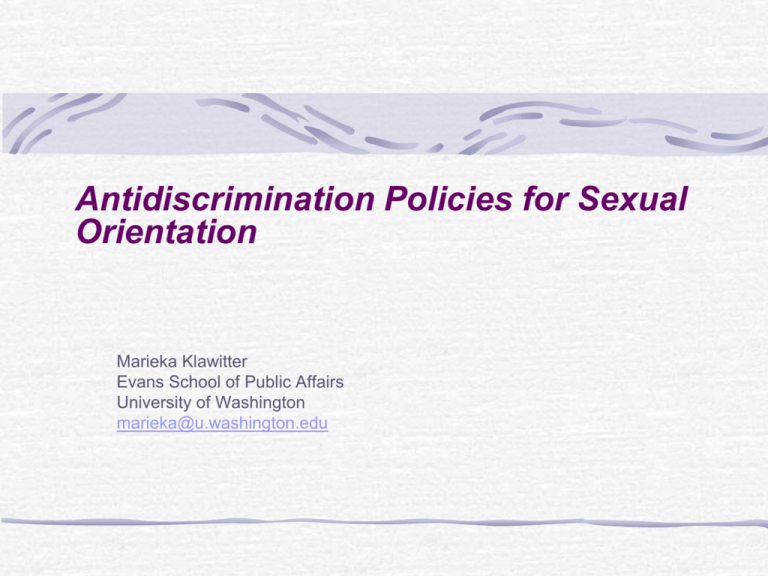
Antidiscrimination Policies for Sexual
Orientation
Marieka Klawitter
Evans School of Public Affairs
University of Washington
marieka@u.washington.edu
Antidiscrimination Policies for Sexual orientation:
Adopted beginning in the 1970s by Cities, Counties, and States
usually added sexual orientation to existing protections
Provide a process for addressing discrimination and could
prevent discrimination in hiring, firing, promotion, and wages
Could increase average earnings for sexual minorities by
creating penalties or by increasing salience or changing norms
Policies covering only government workers may be less
effective because of the preexisting civil service processes, they
cover fewer workers, and may create less salience.
Policies covering private sector workers are likely to cover many
more people in jobs with more discrimination
Antidiscrimination Policies for Sexual Orientation:
How many state and local policies are there?
Where have the policies been passed?
What factors help explain their passage?
What do we know about their impact?
Local policies adopted over time (cumulative)
State policies adopted over time (cumulative)
Percentage of the US population covered over time
What makes them more likely to pass?:
Political factors: Limited scope of debate and
salience, framing as an incremental change to
existing policy, policy entrepreneurs, advocacy
resources all affect passage
Demographics: Policies more likely in local areas
with more highly educated, more urban, less religious
populations.
Adopted in places with higher average earnings for
all workers
Adopted by states with local policies within, by local
governments with nearby localities with policies.
Policy Impacts:
Complaints are brought under laws at slightly lower
rates than for other minority groups.
State but not local policies are associated with higher
average earnings for gay men in private sector
employment, but no evidence of policy effects for
lesbians
Evidence of impact of policies was greatest for white
men working in private sector, for weeks of
employment (not hourly earnings), and those in upper
half of earnings distribution
Conclusions:
State and local antidiscrimination laws for sexual orientation
continue to be adopted and continue to be used by many
seeking fair treatment in employment
Effects on average earnings are small and limited to men in the
private sector
State laws are more effective than are local laws
Passage of federal protections are likely to be even more
effective given enforcement mechanisms and coverage
expanded to less tolerant places
Other types of policies are required to improve labor market
outcomes for people of color, women, those with lower
education and pay








